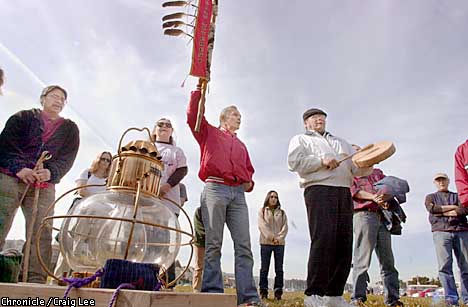|
|
Canku Ota |
|
|
(Many Paths) |
||
|
An Online Newsletter Celebrating Native America |
||
|
February 23, 2002 - Issue 55 |
||
|
|
||
|
Activists Carry Torch
for Peace |
||
|
by Charles Burress, San
Francisco Chronicle Staff Writer-February 12, 2002
|
||
|
credits:American
Indian Movement leader Dennis Banks stands near a flame from the burning
embers of the atom bomb dropped on Hiroshima. Peace activists are taking
the flame across the country. Chronicle photo by Craig Lee
|
 Just
23 days after the Olympic torch passed through the Bay Area, another revered
flame has arrived here -- one that burns with a far darker past and a
brighter hope for the future. Just
23 days after the Olympic torch passed through the Bay Area, another revered
flame has arrived here -- one that burns with a far darker past and a
brighter hope for the future.
The "Hiroshima Flame" -- kindled 57 years ago from embers of the atomic bombing of Japan -- entered San Francisco across the Golden Gate Bridge yesterday morning as it slowly wends its way across America. Its escorts are a diverse group: a seemingly indefatigable Japanese nun who's walked across the United States four times, a Native American elder from Massachusetts, an idealistic 15-year-old girl from Honolulu, and others united in the hope that their unusual spiritual pilgrimage will foster world peace. The five-month journey is a kind of walking meditation with a Japanese Buddhist chant, the beating of small fanlike drums and visits to the places where America played Prometheus with the thermonuclear fire. The itinerary, by foot and bus, includes Lawrence Livermore National Laboratory, which researches nuclear weapons design; Los Alamos, N.M., where the first atomic bombs were developed; and Oak Ridge, Tenn., where the uranium for the Hiroshima bomb was extracted. It also includes many small communities, the White House and a vigil at the World Trade Center site. "I see ourselves as a ribbon of light -- a ribbon of light across America," said Tom Dostou, a Native American elder from the Wabanaki tribe who came up with the idea for the peace walk. They began Jan. 15 at Chief Seattle's grave in Washington state, and one goal is to honor Native Americans who've suffered from atomic testing and uranium mining -- especially anti-nuclear activist and former uranium miner Dorothy Purley of Laguna Pueblo in New Mexico, who died 14 months ago of cancer. After their concluding stop at the United Nations, the flame -- which is carried in a glass lantern -- will be taken to a uranium mine on Native American land in Arizona and extinguished, thus closing the nuclear circle, said American Indian Movement leader Dennis Banks, who joined the group for part of their walk yesterday. The lantern was lit from a flame that is maintained in Hoshino, Japan, by the family of Tatsuo Yamamoto, who gathered burning embers from his uncle's destroyed bookstore near ground zero in Hiroshima. The dropping of the bomb -- the most concentrated killing of men, women and children ever committed -- took an estimated 120,000 to 150,000 lives. Yesterday Banks held an eagle-feather staff as he conducted a ceremony with sage smoke on the Marina Green with about 60 people who gathered in a reverent circle. About two dozen people are making the entire pilgrimage, joined by varying numbers of local supporters along the route. The ceremony marked the 24th anniversary of "The Longest March," a cross- country trek to Washington, D.C., from Alcatraz protesting abuses of Native American rights. A participant of that march and the organizing spirit of the current "2002 Hiroshima Flame Interfaith Pilgrimage" is Jun Yasuda, a Japanese nun famous for her untiring devotion to walking for peace. With shaved head and the orange-and-white robes of the Nipponzan Myohoji sect, which is known for building peace pagodas around the world, she keeps the group moving with her brisk and cheerful energy. "People do not realize we're the same humans," Yasuda said yesterday after crossing the bridge. "Now science . . . can easily destroy the planet. If we keep fighting, not only will humans be finished, but the whole planet. (Peace) is our responsibility." "I think this can have an impact," said Annie Elfing, 15, of Honolulu, as the group walked toward downtown San Francisco, many chanting, "Na mu nyo ho renge kyo" (which can be translated as "Glory to the Sutra, Hail Lotus Sutra"). Annie, who met Yasuda at a peace vigil at the Pearl Harbor memorial, felt the walkers could inspire others by example, "like Gandhi." "If people see us," she said, "they think about what's happening."
|
|
|
||
|
|
||
| Canku Ota is a free Newsletter celebrating Native America, its traditions and accomplishments . We do not provide subscriber or visitor names to anyone. Some articles presented in Canku Ota may contain copyright material. We have received appropriate permissions for republishing any articles. Material appearing here is distributed without profit or monetary gain to those who have expressed an interest. This is in accordance with Title 17 U.S.C. section 107. | ||
|
Canku Ota is a copyright © 2000, 2001, 2002 of Vicki Lockard and Paul Barry. |
||
|
|
|
|
|
The "Canku Ota - A Newsletter Celebrating Native America" web site and its design is the |
||
|
Copyright © 1999, 2000, 2001, 2002 of Paul C. Barry. |
||
|
All Rights Reserved. |
||
